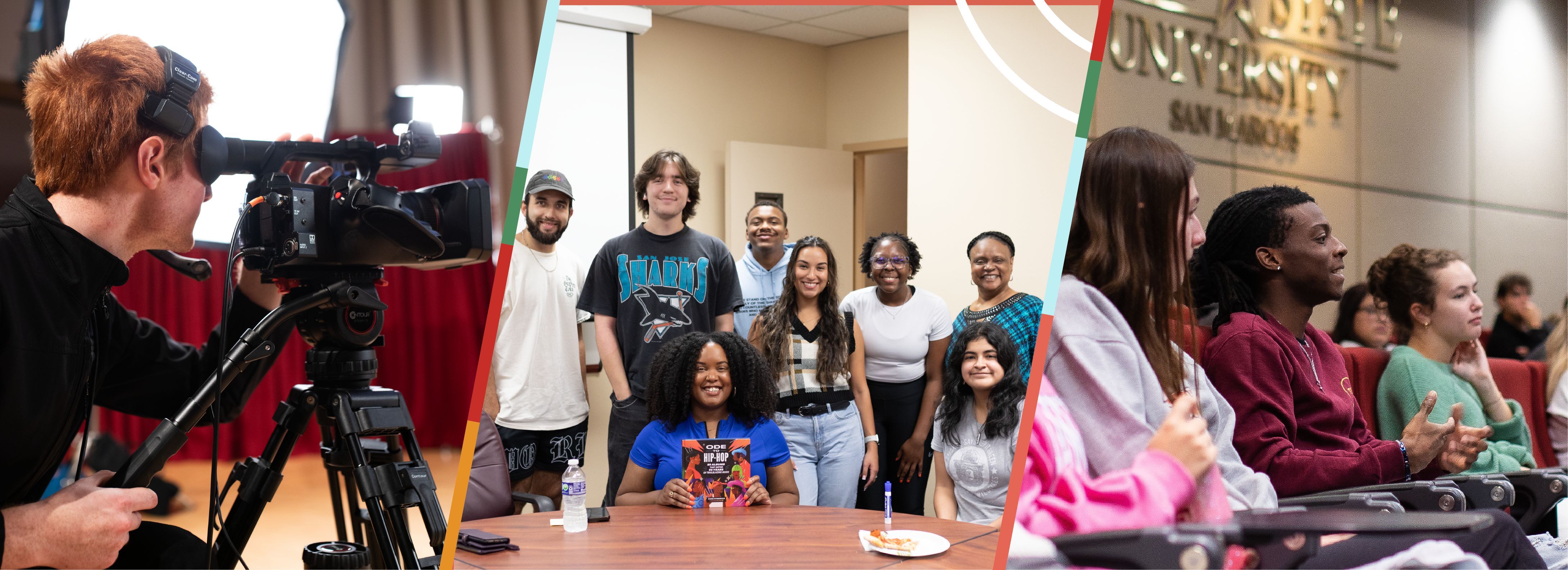Teaching and Learning During a Pandemic

The Pivot to Online
The pivot to online learning was abrupt and unexpected for all of us, both faculty and students, in colleges and universities across the nation and around the world. Like most universities, Texas State adjusted. In the Digital Media Innovation (DMI) program, faculty are astute at digital tools and concepts, and we teach many topics in online and hybrid formats. However the quick shift to online teaching and learning presented unique opportunities and challenges for each instructor and course.
Distance education is not a new area in journalism and mass communication programs (Reis et al,. 1999; Casteneda, 2011; Blankenship & Gibson, 2015; Smallwood & Brunner, 2017; Loizzo, et al., 2017). Many programs have delivered online and hybrid offerings in their programs and offered massively open online courses for professionals or the public (see the Knight Center for Journalism in the Americas at the University of Texas and Northwestern University's Medill School).
At Texas State, we have implemented distance education in courses that are completely online or hybrid before the pandemic shift occurred. Our Fundamentals of Digital and Online Media core course is regularly taught in a hybrid manner as a large class split with alternating in-person and online activities and often delivered completely online for some sections. We have implemented a short course series, in which many of these courses are introduced to students in several online modules, culminating in an in-person workshop. The PhDigital Bootcamp, funded by the Knight Foundation, is an annual activity consisting of 10 weeks of online modules in preparation for a week in residence on our campus during the summer to prepare future faculty to lead innovative curriculum. We have had to adjust to online methods to substitute for the in-person aspect of that program this year, as well.
In addition, the courses we teach in digital tools, social media and multimedia provide us a strong background in which to launch an online course. So, we have a range of experiences that support a shift to online teaching. However, moving courses to an online scenario in a matter of days was a massive undertaking, occurring amidst fear of a global pandemic and anxiety about the effects on the economy into which students would be graduating. Our efforts resulted in a successful completion of the semester, and we felt our processes, techniques and lessons learned would be valuable to share.
In this series, DMI faculty, who teach a range of mass communication courses, describe the ways in which they adapted and adjusted their classes during the second half of the Spring semester. Over the next several days, we will publish individual articles that will ultimately be organized into a single forum.
Articles in this Series
Adapting is Vital for Both Large and Small Classes, Jon Zmikly, June 15, 2020 - Zmikly talks about transitioning a large class to online learning, which included leading teaching assistants, as well as advanced lab-oriented courses in Coding and Virtual Reality.
Different Courses, Different Challenges, Sara Shields, June 12, 2020 - Shields compares the shift to online for her Advanced Social Media course and her Web Design sections.
A Tale of Two Web Design Courses, Dale Blasingame, June 11, 2020 - Blasingame discusses the ways in which students in different sections of the same course may have different needs and how that is magnified in an online environment.
Moving Out and Going Mobile, Kelly Kaufhold, Ph.D., June 9, 2020 - In this article, Kaufhold addresses the use of smartphone in multimedia reporting and other shifts necessary to move his Multimedia Journalism course online.
Challenges for Hybrid and Lab Courses, Cindy Royal, Ph.D., June 8, 2020 - Royal discusses the challenges experienced by even hybrid courses turned completely online, as well as reflections on assisting students with lab-based topics.
References
Blankenship, J. C., & Gibson, R. (2016). Learning alone, together: Closed-cohort structure in an online journalism and mass communication graduate program. Journalism & Mass Communication Educator, 71(4), 425-439.
Castañeda, L. (2011). Disruption and innovation: Online learning and degrees at accredited journalism schools and programs. Journalism & Mass Communication Educator, 66(4), 361-373.
Loizzo, J., Watson, S. L., & Watson, W. R. (2018). Examining instructor and learner experiences and attitude change in a journalism for social change massive open online course: A mixed-methods case study. Journalism & Mass Communication Educator, 73(4), 392-409.
Reis, R., Stavitsky, A. G., Gleason, T., & Ryan, W. (1999). Journalism at a distance: The Oregon experiment. Journalism & Mass Communication Educator, 54(4), 14-27.
Smallwood, A. M., & Brunner, B. R. (2017). Engaged learning through online collaborative public relations projects across universities. Journalism & Mass Communication Educator, 72(4), 442-460.
